
“Hi mom, it’s me, calling from Sweden.” This will have to be short. It is expensive. “When was Grandma born?” “What was her father’s name?” I need some crumb of information if we are to have any luck tracking down relatives, and this was all unplanned. 1897. Carl Corsberg, from ”Smaland”. That will have to do; she knows almost as little as I do.
And yet there we were, in the middle of southern Sweden, at the Swedish Emigrant Institute, full of old ship manifests, church records, US and Swedish census data, microfiches. It was now or never. It was 1998, and we were on a road trip through Scandinavia. At the last minute, researcher Sally had discovered that we would pass through Vaxjo, the site of the Institute, on the way to Stockholm, so why not try to track down my Swedish genealogy? About which I knew nothing, other than those few fragments just now gleaned from my mother. I was the skeptical eye-roller.
It is not so easy to research Scandinavian names. Historically, most Swedish family names changed each generation, taking the father’s first name (e.g. Nils Anderson) and turning it into the child’s last name (e.g. Gustav Nilsson), whose own child would be, say Sven Gustavson—and so on. To make it worse, there seemed to be a recurring handful of names (Magnus, Sven, Gustav, Karl, Peter, Anders etc). And “Smaland” is not a town, but the region of Sweden from which came most of the many thousands of emigrants who left in the late1800’s. In fact, so many emigrants went to the Midwest, the Institute sponsors annual “Minnesota Days” reunion events.
The young man on the staff who helped us, reluctantly at first given our meagre information, got more excited when he found the name was unusual; Corsberg (in Swedish, Korsberg) was probably a place name, possibly adopted from a stint in the army where “knekt” names were used to distinguish between all the fellows with identical names. There was hope.
He quickly dug out evidence of Korsbergs, at least one of them born in Korsantorp (close enough to make it the source of a knekt name), others from Brunshult, both spots reportedly close to Hjortsberga (the only name on any map), and not far from where we were in Vaxjo! The chase was on. We hazarded fruitlessly through one lane roads in forests and farmlands in the general direction of Hjortsberga, hoping for some revelation in the red or yellow painted wooden farmhouses scattered over the landscape. No magic.
Shadows lengthened, and we made our way to Hjortsberga, where we came upon the inevitable town church. Figuring that we might as well make use of what remained of the late summer evening, we ambled through the graveyard with little expectation, armed with a rudimentary list of names from the Emigrant Institute. And there were the headstones! Korsberg, Brunshult: bingo. Unbelievable.
Who knew, maybe some relatives still lived in the area. On the street was a phone booth, with a phone book (not unbelievable in 1998). Go ahead, look inside. There were indeed a few Korsbergs. I had to be prodded to make a cold call to a random name, and struggled when a Swedish-speaker answered. But Ingalil connected me to daughter Lina, who knew some English; when she understood the outline of our story, she thought maybe we should speak with Vivi, the widow of an elderly Korsberg who still lived out on the old family farm. We were invited for coffee and cake (what else?) the next day.
Vivi lived in a red farmhouse out in the countryside–we may even have passed it the day before. In the grass on the side of the road, sat an ancient engraved stone reading “Brunshult”—not a town, but a place. And so we met up with Ingalil, spouse Bo, Vivi, and son Matts to sit around the table, tell stories through Lina our translator, and pore over an ancient bible with names on the frontispiece. The family tree we had constructed made clear how the farm would have passed from oldest son to oldest son, which matched up with Vivi’s deceased husband and his parents. There was lots of smiling and nodding to make up for the language gap, and piecing together the old records was a bit of a stretch, but everyone was willing to give us the benefit of the doubt that there could be some family connection. Of course, I had brought no pictures or documentation from the US, just my word.
Then suddenly Vivi’s face brightened. “Oh,” she cried, “the Americans!” She disappeared up the stairs and returned with an old photograph. There was Carl, the son who had emigrated, with the wife and children he had acquired in Colorado, sitting proudly in a formal group picture. And the daughter the front row, the last one on the left, I recognized–my grandmother Esther.


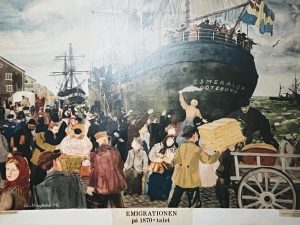
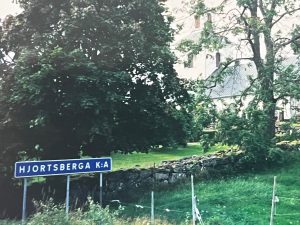
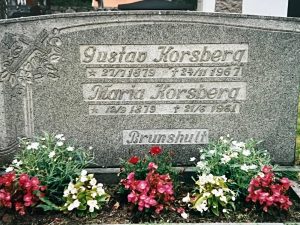
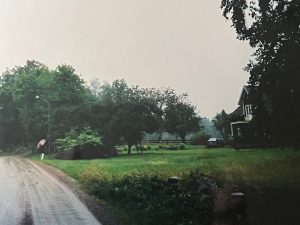
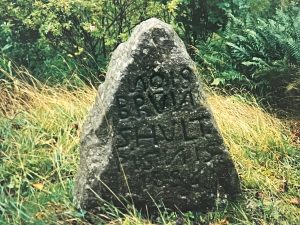
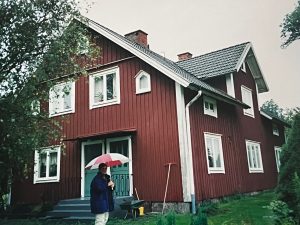
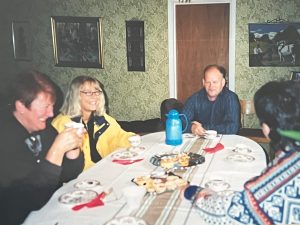
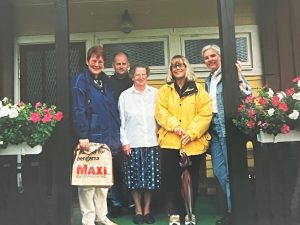
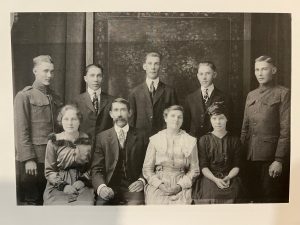

Khati, what a wonderful story! Amazing that your spur-of-the-moment decision to go to the Swedish Emigrant Institute ended up connecting you to a branch of your family you hadn’t known about before. Very exciting! I love the photo of “the Americans” with your grandmother Esther immediately recognizable to you.
Thanks, Suzy. I was inspired by all the great old pictures people had posted, which reminded me of the group photo from Sweden. It was indeed very serendipitous and surprising to get to visit the old homestead–gave me a much better idea of family history.
Your photo and experiences are an amazing gift, Khati. You persisted in your search and it paid off with wonderful in-person meetings and a photo. Fascinating about the Swedish names … and I thought Jews had the only complexity. I’m very happy for you that you could “meet” your relatives this way.
I felt incredibly lucky indeed. In the US, many of us are second or third generation settlers, and the ties to the previous countries cut in many ways, voluntarily or not. In recent years, virtual databases have made searching exponentially easier. But there is still no substitute for being physically in the places where our forebears were, to try to grasp our history.
Oh my Khati, what a truly wonderful story of serendipity and your connection to your family abroad.
I’m sure you’re in close touch with your Swedish relatives, and might they visit you some day in Canada?
I wish that were so. I kept up yearly cards with Lina for a while, and do keep trying, but then no response—moved? Who knows. She had a son, and sent a very cute picture—must be a young man by now. I assume Vivi has died, and Bo and Ingalil were very limited in English—in their seventies or older by now. It would be wonderful to have them come visit—if anyone were doing that any more—and I haven’t returned to Sweden. In any case, the information is in a file in case any younger relatives decide to try to connect some day. Just glad to have had the luck when I did.
Wow, what a happy and exciting final sentence! Up to then, I will admit that my favorite part was the cake and coffee. Thanks for taking readers along on a very pleasant trek.
I was amazed. My grandmother was obviously much younger in the picture than when I knew her—but it was unmistakably the same person! The coffee and cake seems to be an inviolable tradition.
So glad you made an actual connection through that photo. Your story read like an adventure, which I very much enjoyed.
It WAS an adventure, with an unexpected and happy ending. Glad you enjoyed the journey.
I confess, a chill ran up my spine when Vivi said, “Oh, the Americans” and ran off to find the photo, and I teared up when you recognized your grandmother. An amazing story of persistence and discovery, Khati. How did you feel in that moment of recognition?
The Holocaust left families torn apart and scattered around the globe. My maternal grandfather had two sisters who stayed behind in the “old country”. After WWI it became part of Poland and all except one daughter (who married a Zionist and escaped overland to Palestine in 1939) died. My brother spent two years in Israel during his studies to become a rabbi. He decided to try to find this woman, who was our mother’s first cousin. He didn’t even know her maiden name, much less her married name, just that she and her husband came from Bialystock (now part of Lithuania). In 1971, my brother went to the organization set up to help locate displaced people. My brother presented those few facts. The man he spoke with said it wasn’t much, but he had served in the army with a man who came from Bialystock – Yaacov Nishri. Perhaps he could help my brother. Yaacov turned out to be married to our cousin Paula! Rick contacted them, went up to Tel Aviv and met with them. Rick said she looked SO much like our mother. I visited the summer of 1972. It was hot and I wore my long hair braided and crossed across the top of my head (like Heidi). Rick took me up to meet our cousins (I speak no Hebrew, my brother is fluent). Paula opened the door, took one look at me and almost sobbed. She said I looked like her murdered sister Eshki. I stayed with them, on and off, for two weeks. Though we couldn’t speak to each other (sign language – they fed me constantly), the love was immediate. They had three daughters. Their youngest, Hannah, was just out of the army, a year older than me and spoke excellent English, so we became friendly. We wrote to each other for a few years, but I was in college and busy, so the correspondence petered out and they are again lost.
Betsy, what an amazing story you have, and how wonderful to have been able to connect so beautifully, when it was not really expected. Life sometimes provides some true moments of joy, and your story touched me. Thank you.
Just as your story touched me, Khati. I didn’t mean to intrude on your wonderful adventure, but somehow your story resonated with me. I suppose I should just write my own, prompted by yours. A version of it is embedded in “Holy Land, Shmoly Land”, but that is about the entire trip to Israel, which was NOT a fun adventure.
It would indeed be a good topic to write on–you got a very good start! My sister had a somewhat similar experience to you when she visited a great aunt for the first time, and when she opened the door, my sister was told she looked just like our grandmother–the one who died young and long before we met her. Shivers.
Khati, an enchanting saga. What are the odds of everything coming together as it did for you? The older I get and the more I experience, the less I believe in earthly coincidences. A blessing, this magical experience of yours. And what a charming photo of the American Corsbergs. (Look at all those strapping sons!)
Perhaps the saddest family photo I have ever seen is of a Swedish family that perished on the Titanic as they were emigrating to the U.S. As I understand it, a family would take a photo before they left Sweden and then take and send back a family photo from their new home.
It was a remarkable feeling to have the unexpected connection across time, space, language and continents. Maybe just all coincidence or not, but a welcome happenstance. The Emigrant Institute actually had an exhibit on the Titanic, and Swedes who perished on it. The picture I saw was, I believe, one of those made precisely for the purpose of sending proof home to the family of what happened after the emigration. Rarely would those who left ever see their families of origin again, and the connections to the “old world” became lost as settlers mixed and turned into “Americans”.
Bravo and congratulations on the success of this quest! I have old pics of the generation that came over from Italy. I imagine walking through the streets of Cosenza, looking at faces for someone with a resemblance. The Norwegian half, I have nothing.
I thought I had nothing in the Swedish quartile either, but surprise! You might be able to dig up more than you realize, especially with the electronic databases these days. We recently came up with an ID of the mysterious mother of my aunt and uncle through ancestry.com, but that is another story.